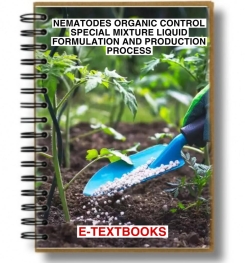The body of a nematode is long and narrow, resembling a tiny thread in many cases, and this is the origin of the group's name. The word "nematode" comes from a Greek word nema that means "thread". Theepidermis (skin) of a nematode is highly unusual; it is not composed of cells like other animals, but instead is a mass of cellular material and nuclei without separate membranes. This epidermis secretes a thick outer cuticle which is both tough and flexible. The cuticle is a feature shared with arthropods and other ecdysozoans. As in those other groups, the cuticle is periodically shed during the life of a nematode as it grows, usually four times before reaching the adult stage.
The cuticle is the closest thing a roundworm has to a skeleton, and in fact the worm uses its cuticle as a support and leverage point for movement. Long muscles lie just underneath the epidermis. These muscles are all aligned longitudinally along the inside of the body, so the nematode can only bend its body from side to side, not crawl or lift itself. A free-swimming roundworm thus looks rather like it is thrashing about aimlessly.
The muscles are activated by two nerves that run the length of the nematode on both the dorsal (back) and ventral (belly) side. Unlike other animals, where the nerves branch out to the muscle cells, a nematode's muscle cells branch toward the nerves. The ventral nerve has a series of nerve centers along its length, and both nerves connect to a nerve ring and additional nerve centers located near the head.
The head of a nematode has a few tiny sense organs, and a mouth opening into a muscular pharynx (throat) where food is pulled in and crushed. This leads into a long simple gut cavity lacking any muscles, and then to an anus near the tip of the body. Food digested in the gut is not distributed by any specialized vascular system, and neither is there a respiratory system for the uptake or distribution of oxygen. Rather, nutrients and waste are distributed in the body cavity, whose contents are regulated by an excretory canal along each side of the body.
Many nematodes are able to suspend their life processes completely when conditions become unfavorable; in these resistant states they can survive extreme drying, heat, or cold, and then return to life when favorable conditions return. This is known as cryptobiosis, and is a feature nematodes share with rotifers and tardigrades.
Fossil nematodes have been found in rocks from as early as the carboniferous.Most living roundworms are microscopic, meaning that their discovery as fossils is likely to be difficult. On the other hand, one species of parasitic nematode can reach 13 meters in length -- it parasitizes the sperm whale. Nematodes also lack any substantial hard parts, again resulting in a spotty chance for fossilization. Despite these problems, fossil nematodes are occasionally found in amber (fossilized tree resin) from the cenozoic. Because many of their relatives have left fossils dating from the cambrian, it is likely that the nematodes have been around at least that long in some form.
If you've wandered around our exhibits much, you've seen many groups described as living just about anywhere. That statement goes triple for nematodes, who live not only in almost every geographic location on Earth, but live in such extreme habitats as ice and hot springs, as well as living on or in almost every other kind of animal and plant alive today. Free-living nematodes are extremely abundant in soils and sediments, where they feed on bacteria and detritus. Other nematodes are plant parasites and may cause disease in economically important crops. Still others parasitize animals (including humans); well-known parasitic nematodes include hookworms, pinworms, Guinea worm (genus Dracunculus), and intestinal roundworms (genus Ascaris).
NEMATODES AND TREATMENTS
It is difficult to treat nematodes in soil.
But it is not impossible.
For preventing plant roots from nematodes, controlling and getting rid nematodes. You can prepare own special organic liquid mixture for killing nematodes yourself, both economically and so effective.
preparation of this special organic liquid mixture, You need some ingredients that you can find your country easily, formulation and production process. You need no help and no technıcal support to make this mixture. simple mixing is sufficient.
Below textbook has a formulation and manufacturing process of special organic liquid mixture and methods of application to treat nematodes. You can produce special organic liquid mixture for getting rid nematodes easily and apply to soil safety.
RELATED TAGS : What is nematode, how to control nematodes, damages nematodes, types of nematodes, struggle with nematodes, fruits, flower,roots, plants,greenhouse,management of nematodes, biological control nematodes, chemical control nematodes, organic control for nematodes on plant roots, meaning of nematodes, nematodes on banana plant roots, pepper roots nematodes, tomato palnt roots and nematodes, treating plants with nematodes,how to control on plant roots. how to treat nematodes of tomato plant roots,how to identify nematodes,description of nematode,introduction of nematode,characteristic of nematodes,Nematodes,nematodes in general,shapes of nematodes,
SOLVERCHEM PUBLICATIONS
|
|
|
|
|
|
|
|
|

